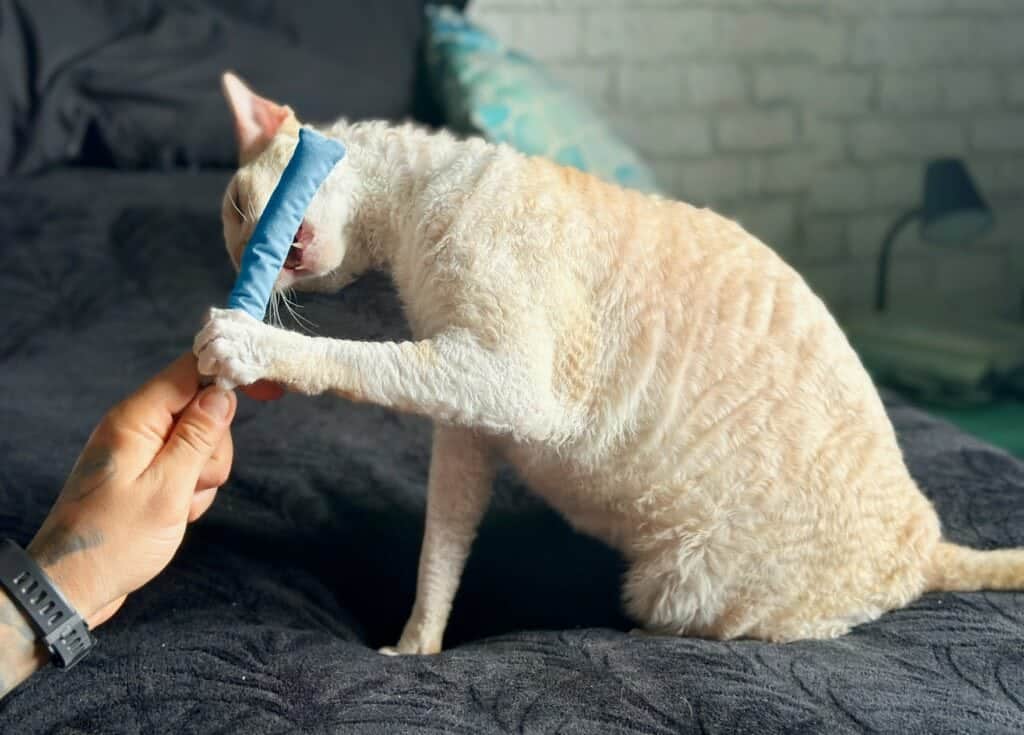
Pet owners know that cats are tenacious when it comes to playing. Part of the reason is that many toys simulate hunting. Think of how many products resemble mice, squirrels, and birds. That instinct runs strong in felines. In many ways, cats are closer to their wild nature than dogs. Canines diversified into so many different roles. Hunting often gets lost, especially in companion animals.
Toys are an excellent way to keep cats mentally healthy, especially if they live indoors. Our roundup of reviews cuts to the chase to highlight the best cat toys to keep your feline BFF happy without the caught mice and voles.
A Quick Glance at the Winners of 2024
| Image | Product | Details | ||
|---|---|---|---|---|
| Best Overall |

|
Hepper Catnip Stick Toy |
|
CHECK PRICE |
| Budget Buy |

|
Hepper Plush Mouse Kicker Toy |
|
CHECK PRICE |
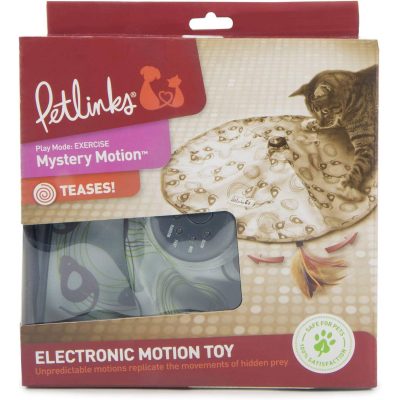
|
Petlinks Motion Electronic Toy |
|
CHECK PRICE | |

|
Yeowww! Catnip Banana Toy |
|
CHECK PRICE | |

|
Petstages Tower of Tracks Cat Toy |
|
CHECK PRICE |
The 12 Best Cat Toys
1. Hepper Catnip Stick Toys — Best Overall

There’s nothing quite like watching your cat go crazy for catnip. A good catnip toy provides hours of fun, and Hepper’s Catnip Stick Toy do more than fit the bill. These durable toys are double-layered with tough material to withstand even the most enthusiastic of cats.
The toys are crafted to give your cat the best experience with catnip and are long and slender to provide a good amount of room to kick and bite. They’re pretty, too; the toys come in lovely pastel colors, which we think is a nice touch. These sticks are filled with 100% organic catnip and can really motivate your cat to exercise. The beauty of this toy, too, is that it needs no adult supervision, so if your cat is home alone, the toy can be used.
Cats need stimulation and exercise to be healthy and happy, so bringing a beautiful, irresistible toy into the home can get them moving in no time. All it takes is one sniff of Hepper’s Stick Toy, and your cat will bounce off the walls. We loved that the toy is made to last and gave it the number one spot as our best cat toy.
At Catster, we’ve admired Hepper for many years and decided to take a controlling ownership interest so that we could benefit from the outstanding designs of this cool cat company!
- Durable
- Filled with 100% organic catnip
- Beautiful pastel colors
- Great for cats to bite and kick at
- Won’t be as fun for cats that don’t react to catnip
2. Hepper Plush Mouse Kicker Toy – Budget Buy

The Hepper Plush Mouse Kicker Toy is one of the best budget-cat toys you can get. Teasing a cat with a lure like this one is sure to be a hit. It gets high marks for how much it will entertain your pet. The only problem is that you may have a hard time getting him to stop playing. It’s a generously large cat toy that small kittens to the biggest of cats can seamlessly enjoy. Made with multitextured fabric means it’s ideal for rough play – no kitty kicks or bites will rip through this toy!
The Hepper Mouse Kicker is infused with organic catnip and features a bell making it the perfect multisensory toy that appeals to your kitty’s touch, eyes, nose, and ears!
The best part might be that it is so affordable, so you can buy replacements when the catnip scent fades or additional toys for multi-cat homes without guilt!
At Catster, we’ve admired Hepper for many years and decided to take a controlling ownership interest so that we could benefit from the outstanding designs of this cool cat company!
- Super affordable
- Multisensory
- Encourages self-play & exercise
- Contains catnip
- Addicting
- Catnip scent will fade eventually
3. Petlinks Mystery Motion Electronic Motion Cat Toy
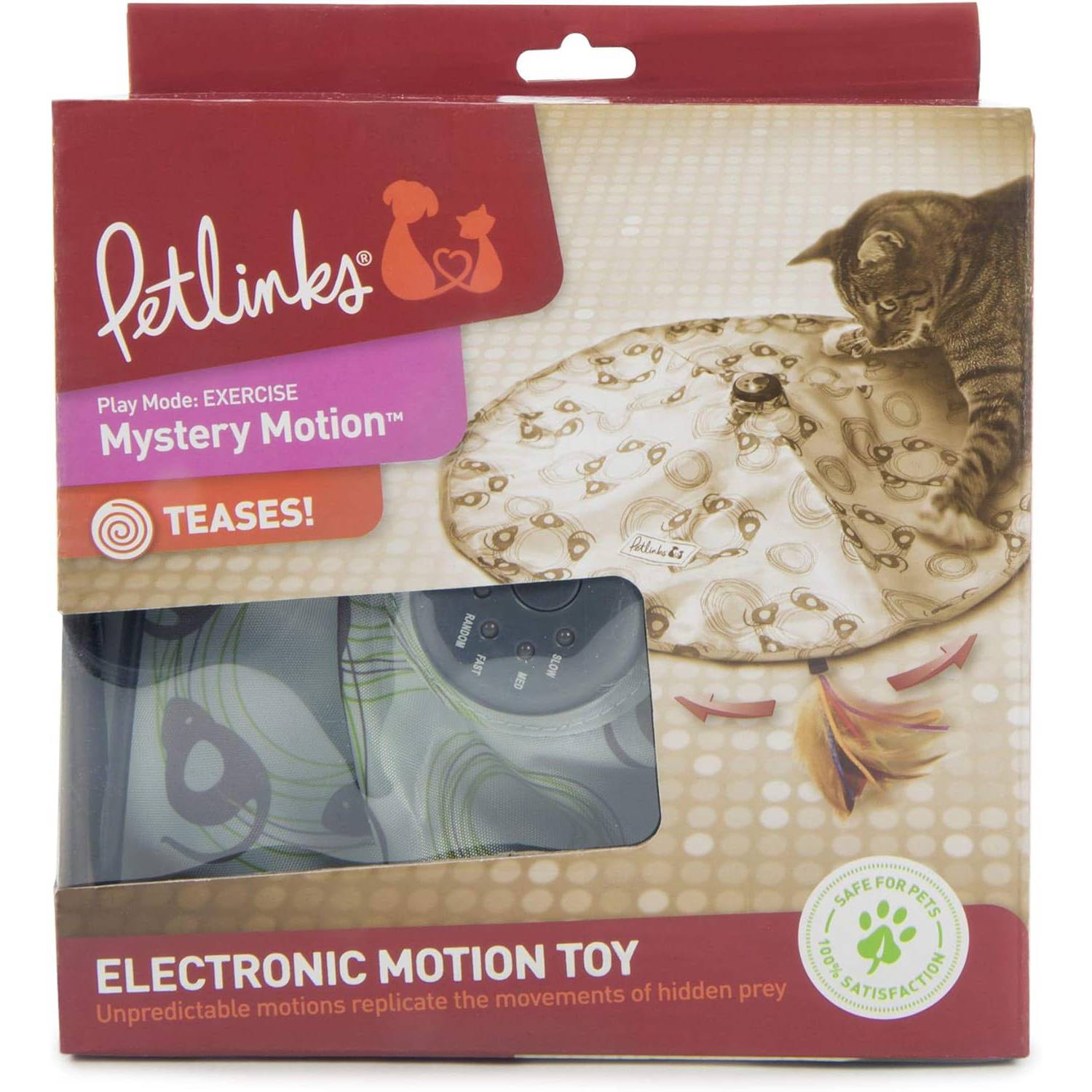
The premise of the Petlinks Mystery Motion Electronic Motion Cat Toy is so simple, yet it’s absolutely brilliant when it comes to engaging your pet. You might think that your feline would get bored with it. Certainly not! Even though the motion just involves going around in a circle, it never gets old. Your cat will still play with it and even paw at it to get you to push the button.
The toy runs on three AAA batteries. While they aren’t included with your purchase, they add some welcome weight to it to keep it upright That’s a great thing because avid fans will turn it up a notch the more they get used to its action. You’ll likely find that your cat may paw at it for you to turn it on so that she can play.
- Four different speed options
- Engaging
- Tips easily
- Batteries not included
4. Yeowww! Catnip Banana Cat Toy
The Yeowww! Catnip Banana Cat Toy may seem large at 7 inches, but the size makes sense. Your kitten can grab hold of it for bunny kicking. The addition of catnip seals the deal. The shape and nip make this toy irresistible. That’s the proverbial double-edged sword when it comes to some pets. They will go off on this banana and may destroy it. Fortunately, it’s not too expensive to replace.
We have to give props to the manufacturer for the design. It certainly is a hit. We liked the fact that it’s made in the USA, too. Unfortunately, it’s not refillable if your cat breaches the outer fabric layer. If that happens, it’s probably done. However, the toy is so darn cute, too. Because of its size, it’s probably a better choice for adults instead of kittens.
- Clever design
- Larger size
- Made in the USA
- Nonrefillable
- Not indestructible
5. Petstages Tower of Tracks Cat Toy
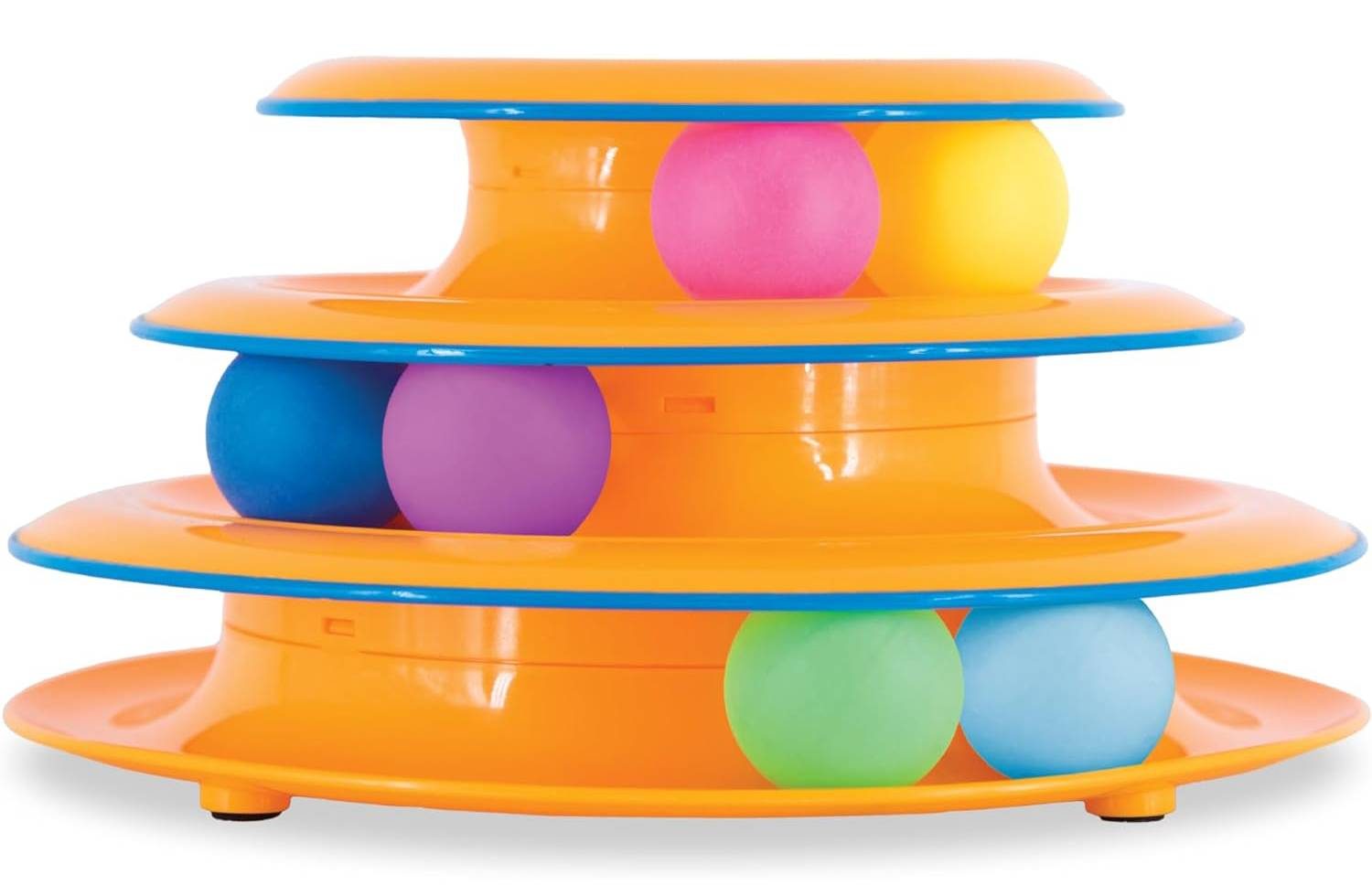
The concept of the Petstages Tower of Tracks Cat Toy is so simple—and so addicting for felines! Cats can’t resist the swirling balls that fortunately they can’t pop out of the rings. The fact that it’s plastic is a boon. It’s easy to clean and keeps the price reasonable. It’s also indestructible, even for the toughest pet. She’s not going to break this one. Instead, she’s going to love it and come back to it often.
While it’s lightweight at only 9.6 ounces, the non-skid rubber feet keep the toy in place if your kitten gets especially zealous in her play. Fortunately, the design accounts for this fact with a quiet usage no matter how intense it gets. This is one of the most popular cat toys this year too.
- Engages pets
- Easy to clean
- Affordably priced
- Some quality control issues
6. SmartyKat Hot Pursuit Electronic Motion Cat Toy
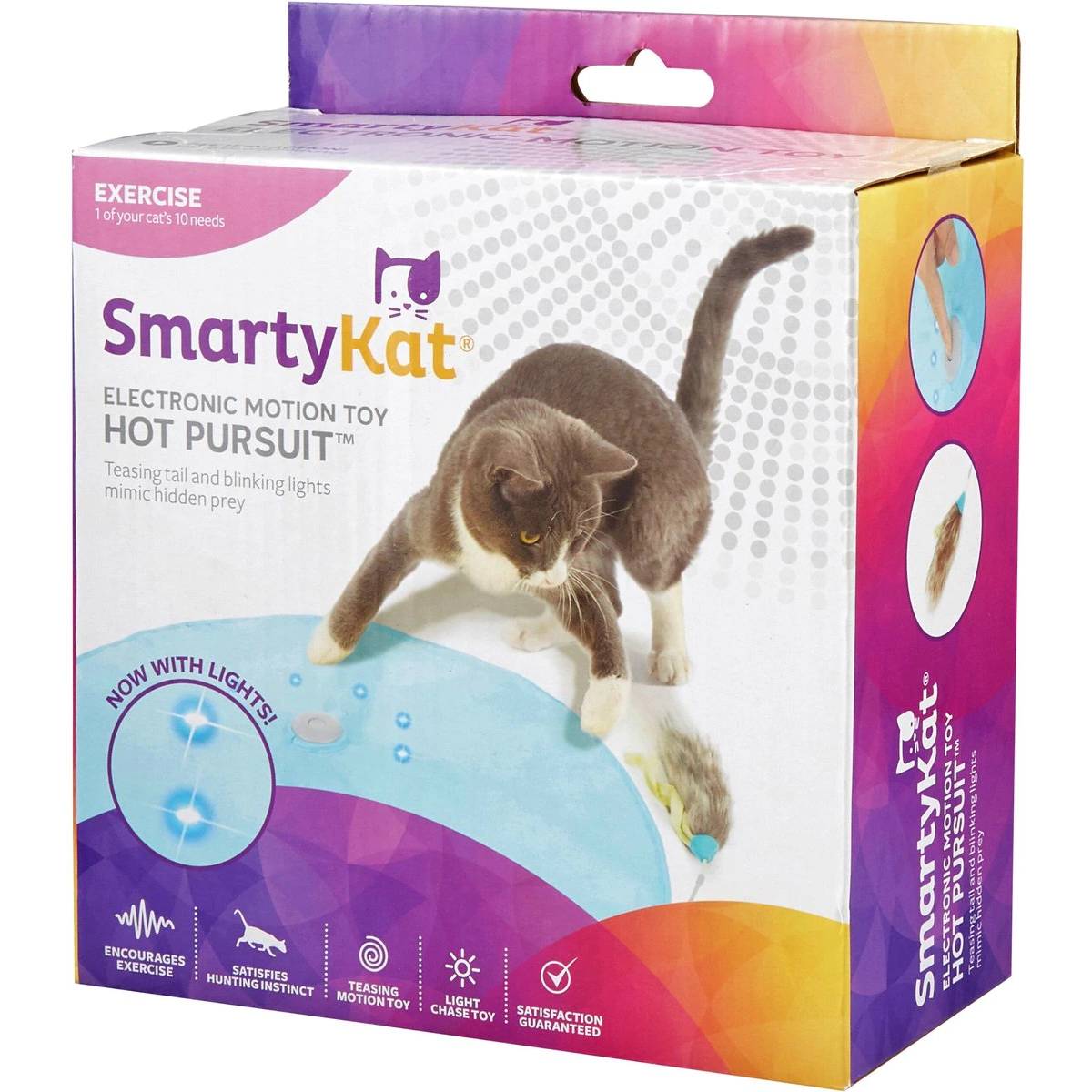
The SmartyKat Hot Pursuit Electronic Motion Cat Toy is another interactive hunting-pursuit product that cat young or old will enjoy and is one of the top cat toys this year. The design is spot-on to simulate prey hiding under the cover. The toy is a flexible rod that adds to the erratic movement. It moves then pauses as lights flash before the action begins again. That addition is brilliant because it builds up anticipation in your pet.
On the downside, it’s easy for an energetic cat to tip over or get her nails caught in the polyester covering. Felines with long claws will put holes in it. On a positive note, we loved the auto-shutdown feature to save on battery life. The toy runs on three AAs. It also includes a small packet of catnip, which isn’t necessary to get your pet’s addition. However, we did appreciate the treat.
- Two speeds
- Toy motion mimics real-life
- Auto shutdown
- Environmentally-friendly construction
- Easy for cats to tip over
- Flimsy cover
7. Hepper Fish and Chews
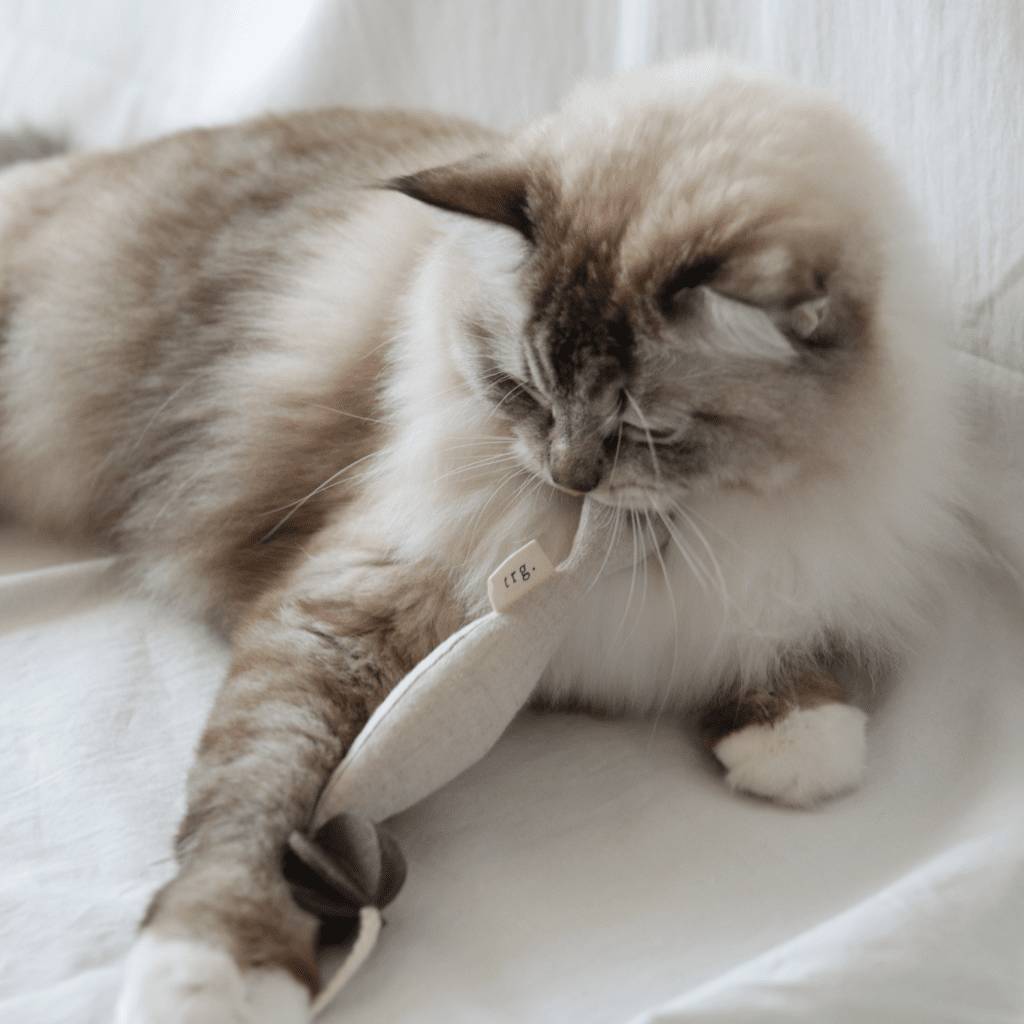
Fish and Chews is an adorable and fun toy for any cat! It is essentially a fishing rod with a sinker and fish on the end, and it provides your cat with multiple playing options. You can dangle the fish so your cat can give chase or just let your kitty play with the fish on its own.
The rod is made with birch and is almost 18 inches long, with a 31- to 33-inch string in a sturdy polyester material. The fish is 7.4 inches and is made with cotton and wool, so it’s nicely sized for cats of all shapes and sizes.
This toy is handmade with primarily natural materials, and it’s machine washable. It’s also available in four colors: beige, ivory, charcoal, and mixed.
The primary disadvantage of this toy is that it’s quite expensive. But given the quality of the materials and the fact that it’s handmade, this isn’t unexpected.
At ExcitedCats.com, we’ve admired Hepper for many years and decided to take a controlling ownership interest so that we could benefit from the outstanding designs of this cool cat company!
- Multiple playing options
- Made with natural materials
- Handmade
- Machine washable
- Available in four colors
- Expensive
8. Frisco Scratch & Roll Scratcher Cat Toy
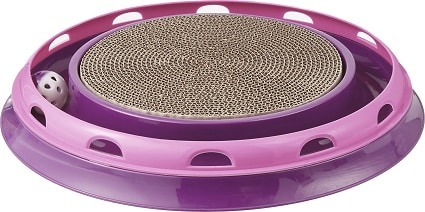
The Frisco Scratch & Roll Scratcher Cat Toy is one of those products that you may have to teach your pet how to use. However, once she gets the hang of it, she’ll love it! It plays on the cat’s instinct to stick with the hunt. The ball is always just out of their reach. The toy also has a cardboard insert on which you can sprinkle a bit of catnip to entice your pet to play. The product comes with a small sample.
The pad helps teach your pet to scratch on something other than the furniture. On the downside, it is messy. You’ll find that you must vacuum often after a rousing playtime. You can get replacements for it. Just make sure to get them from the same brand to make sure they fit. We like how the toy engages our cat. However, it can get loud sometimes.
- Cardboard scratchpad
- Entertaining
- Won’t flip over easily
- Messy
- Loud
9. Frisco Cat Tracks Butterfly Cat Toy
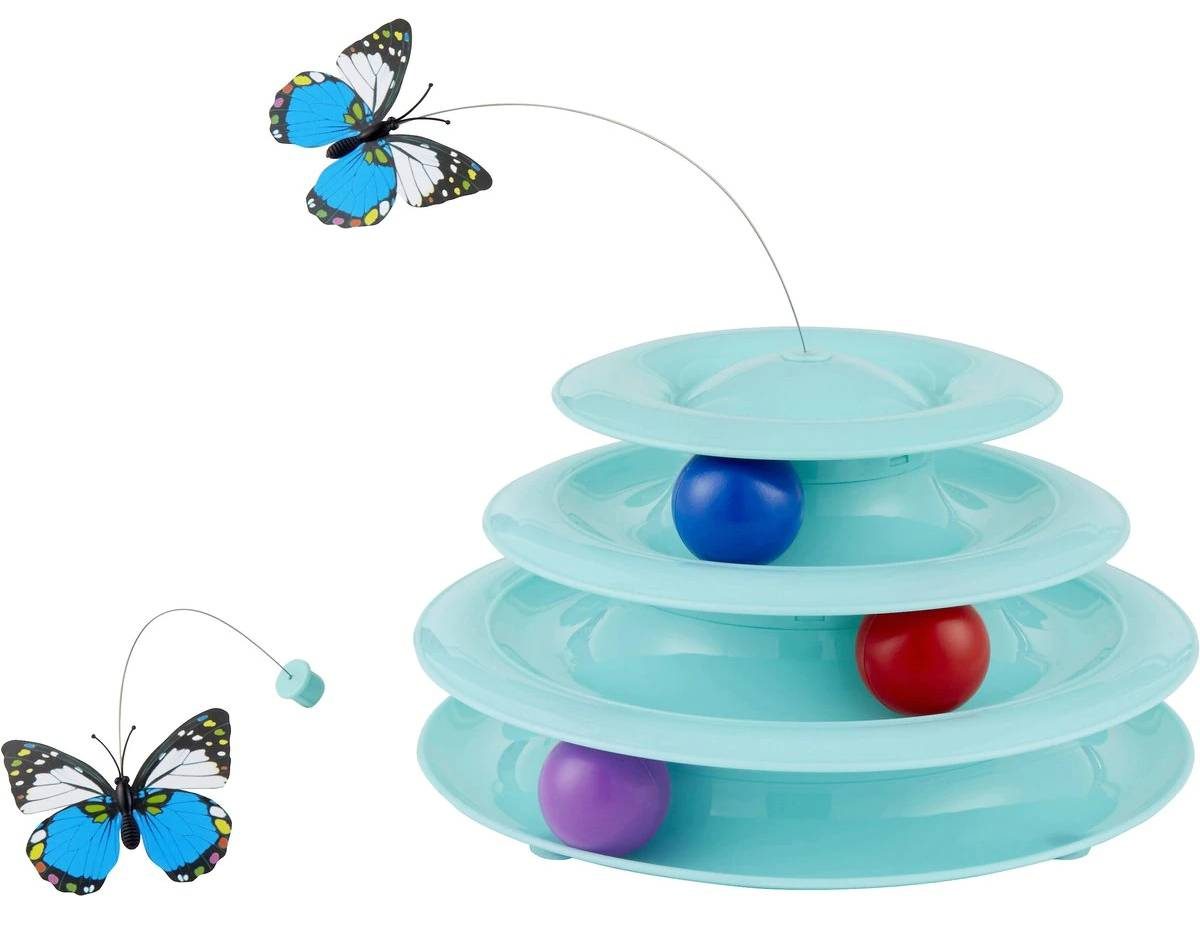
The Frisco Cat Tracks Butterfly Cat Toy is another best cat toy for cats home alone on our list that will amuse your cat. This one has three rings with balls that she can bat inside of them, with each one moving independently of the others. The premise is clever. It also includes two butterfly attachments for the top of the toy. We thought they got more in the way of the rest of it. They were also a bit flimsy.
One issue you may encounter with these kinds of toys is your pet popping out the balls. If she gets a paw underneath them, they’ll go flying. It’s not a big deal to get them back inside the ring. Just don’t lose them. The manufacturer does not sell replacements. We thought that was a fail on their part since it’s inevitable that a cat is going get at least one out of the toy.
- Easy to clean
- Non-skid feet
- Replacement balls unavailable
- Butterflies not well-made
10. Pet Fit for Life Squiggly Wand Cat Toy

The Pet Fit for Life Squiggly Wand Cat Toy is a great way to interact with your pet and reinforce your bond. The value of this product is that it’ll never get boring. You can mix it up and keep your kitty playing. The wand is made of carbon fiber so that it can take a lot of punishment. It comes with five “worms” in different colors, which is more for you than your cat. Replacements are available.
There’s no doubt your pet will enjoy this toy. The wand is long enough to keep your hands and fingers from the frontline. However, we have to admit that it gets boring for us after a while, especially if you’re good at using it. We recommend inspecting the “worm” before playtime. A determined cat will tear it apart easily. There’s a reason that the manufacturer included several additional pieces.
- Excellent action
- Replacements available
- Fun interaction with pets
- Tiresome after a while
- Choke hazard
11. Hexbug Nano Robotic Cat Toy
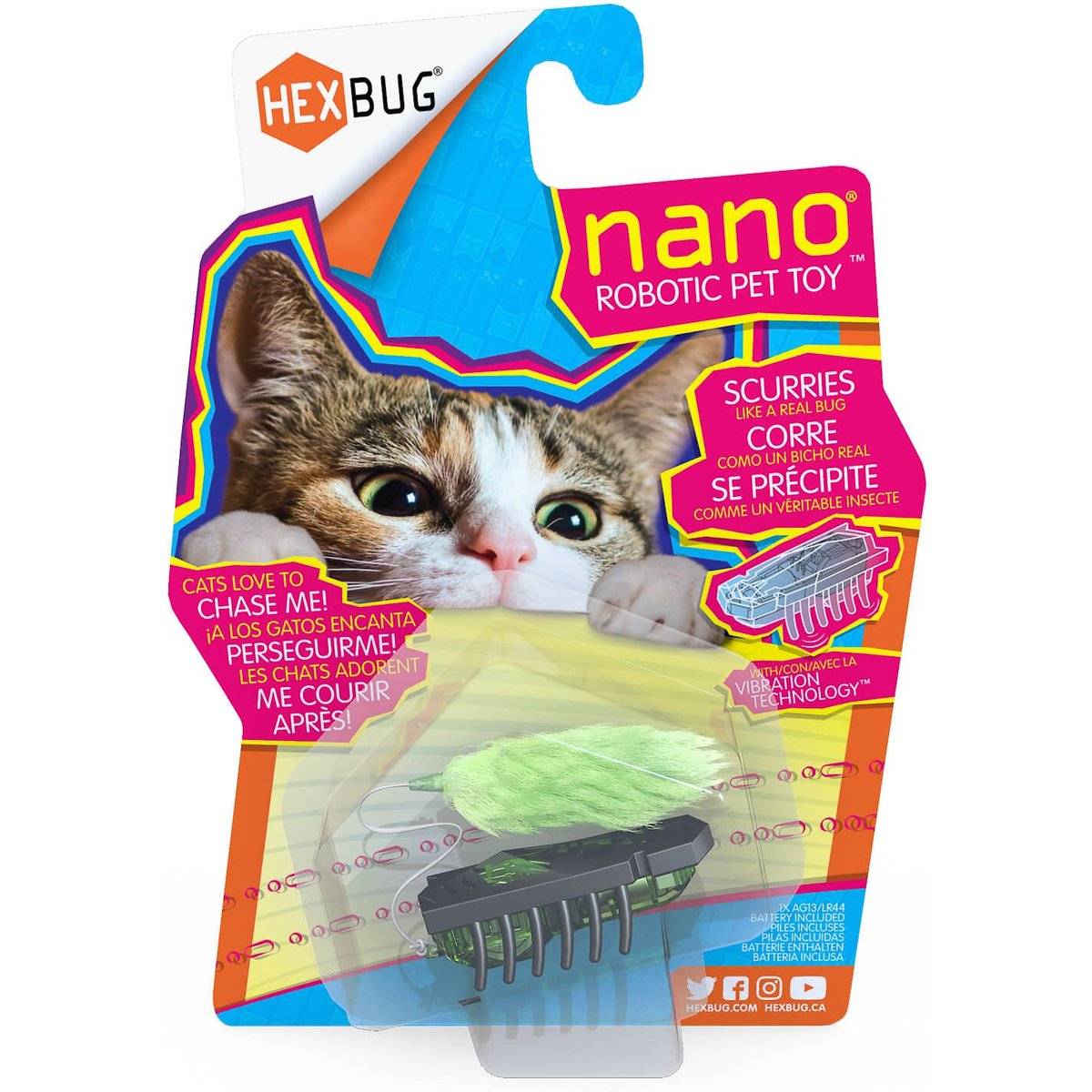
The Hexbug Nano Robotic Cat Toy goes to the other end of the spectrum with a product that takes on the playing task for you. This mouse-like toy scurries around the floor. It runs on an AG13/LR44 battery, which is included with your purchase. The concept sounds fine out of the box. You can think of it as an electronic babysitter for your cat.
There are a few problems. First, it can only work well on hard surfaces. It may move a little on the carpet, depending on how thick it is. The whole point is to get your pet to chase it. The toy goes in random directions, so it can get lost if you’re not paying attention. We also have concerns if a kitten chews on it because of the smaller parts and battery. The latter is toxic and can cause intestinal blockages.
- Hands-off play
- Battery included
- Hard surfaces only
- Gets lost easily
- Choking hazard
12. Hartz Peek & Play Pop-Up Tent Cat Toy
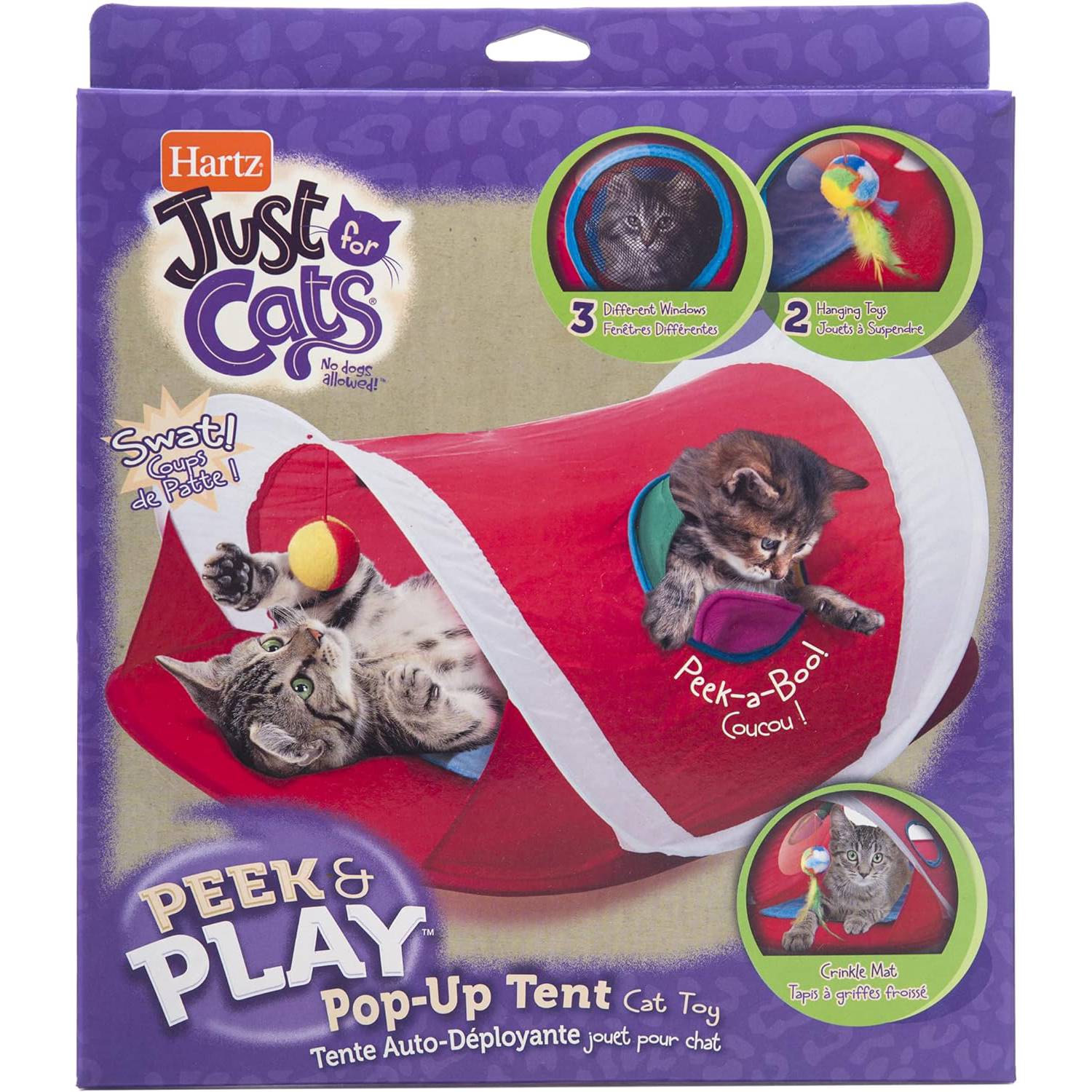
The value of the Hartz Peek & Play Pop-Up Tent Cat Toy is your pet’s instinct to find cover. This product does it well. However, it’s a bit on the small side if you have a larger adult. The holes are also a bit tight to engage in peek-a-boo, as the description suggests. It has a detachable ball that you can put on one of the entrances. Our experience is that cats tire of those types of toys quickly.
We didn’t see this product as much of a toy as a place for your pet to nap. Kittens might make more of a game out of stalking each other than older cats. There is a mat inside of it to make it more comfortable. Unfortunately, the material is a bit thin. Rambunctious pets will make short work of it, too. We were also hard-pressed to see the value of the side openings as described.
- Fun hiding place
- Too small for some adults
- Tight side openings
 Buyer’s Guide: How to Find the Best Cat Toy for Your Cat
Buyer’s Guide: How to Find the Best Cat Toy for Your Cat
As we’ve discussed, cats are a ball to watch playing. Many adults still act like kittens, which we adore. There’s a good reason why we watch the Kitty Halftime show every year. Buying quality toys is just as essential for them as it is for you. Your pet gets the mental stimulation she needs, and you get to laugh at her antics. It’s a feline version of the win-win.
Things to consider when shopping for cat toys include:
- Durability
- Choking risk
- Engagement factor
- Price
All play a role in the value you’ll get from these products. We’ll delve into each one and discuss the essential features to look for in a cat toy. We’ll also provide some tips about the best ways to use them to save you time and money.
Durability
Many pet owners choose to declaw their cats because of their destructive scratching behavior. If your kitten still has her claws, you are probably well-acquainted with the damage they can do. Now, think about toys. If they can shred a carpet, they can do the same thing to a plush toy. The first factor we always consider with these products is how well they will hold up under vigorous use.
After all, the whole point of getting toys is to keep them occupied and as an appropriate alternative to your furniture. Cats are going to scratch something. It’s evitable because it’s instinctive. The thinking among animal behaviorists is that scratching is a form of communication for felines. They are not sharpening their claws as much as they are trying to mark their space.
Think about how cats use their claws. They bring down prey, climb trees, and play with their toys. Ripstop materials, such as nylon, are excellent places to start for finding indestructible products. Even if your kitten only has her back ones, she can still do a lot of damage. That brings us to our next factor.
Choking Risk
Many manufacturers acknowledge the destructive behavior of cats with disclaimers, cautioning pet owners to supervise their animals. That’s sound advice to a point. Felines are independent creatures, with many able to make anything a toy. However, the point is well-taken because a destroyed toy presents a choking hazard if your pet ingests the smaller pieces.
Another risk exists for bowel obstructions if your pet swallows fabric or stuffing materials. That is an emergency that often requires surgery. It’s one reason that we strongly urge you to inspect your pet’s toys regularly. Replacements are much cheaper than the alternative. Even a small tear is enough reason to toss it out and get another one.
Engagement Factor
The engagement factor is a significant selling point with cat toys. Many products like balls will catch your pet’s eye immediately once she spots it rolling away from her. Others have a higher learning curve, making it necessary to show your pet how to use them. Some of the best products play on the feline’s instincts to chase would-be prey.
You’ll find a host of choices, ranging from chews to catnip toys to fake mice. You must also consider your role in play. Products like teasers and wands require action on your part. You supply the engagement factor. We like these items because it reinforces the bonds between you and your pet. Many breeds are quite gregarious, so you may find that your kitten has boundless energy for playing.
There are also interactive and electronic toys, like several in our roundup of reviews. The main benefit of these products is that they challenge your cat. Puzzles and food-dispensing toys make your cat have to think to get the reward. The mental stimulation they provide is priceless. Often, pets will play longer with these kinds of toys. That adds to their value because of the exercise they encourage.
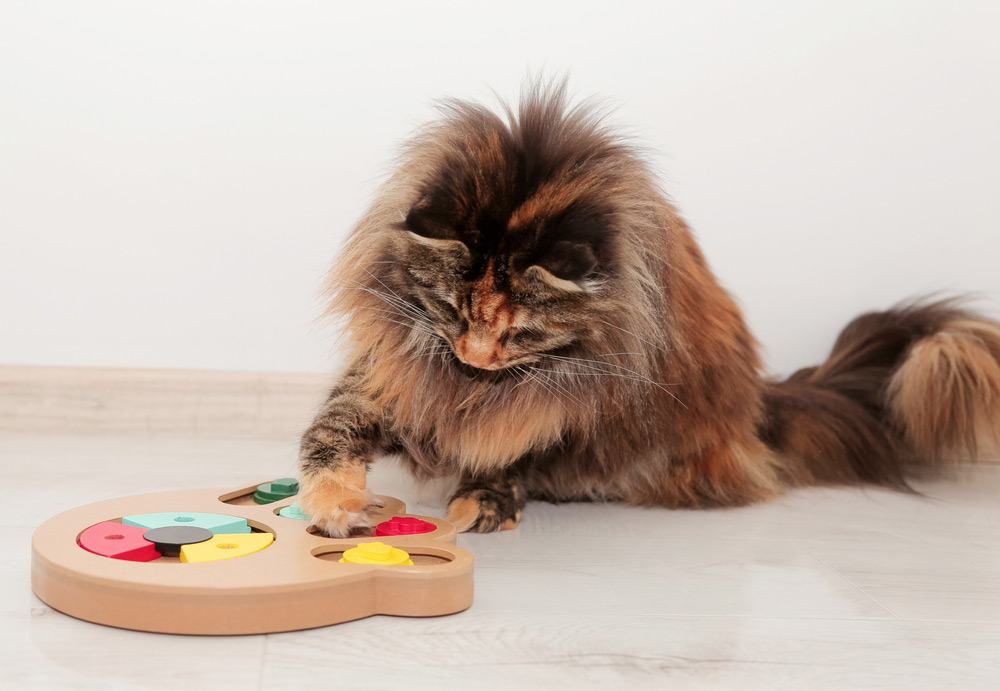
Price
Price is always a consideration. The cost of these products has increased in recent years as pet ownership has risen. There’s also the widening gap between owners and pet parents. People are more likely to think of their companion animals as members of the family. That likely means that they are more willing to pay more to keep them happy.
That fact isn’t lost on the manufacturers and sellers in the industry, either.
Our advice is to stick with companies that produce high-quality products. Toys that won’t fall apart are worth the extra cash upfront. Do your homework, and find out the materials and construction of them before you buy them. It helps to think of your cat as a curious toddler who’ll try to figure out how something works, even if it means breaking it.
We recommend Chewy, and we think it’s one of the best places to find toys for your cat.
Keeping Your Cat Entertained
If you’ve owned a cat for any length of time, you fast realize one thing. These animals are smart and inquisitive. If they can find the trick to something, they will. Their tenaciousness also stokes the fire. These are excellent traits in a pet and make a strong argument for the interactive toys we discussed. However, it also means that your cat may get bored quickly with some products.
The best way to get your pet interested in the toys you buy her is to switch them out once in a while. Let your cat have her fun with one of them. When it looks like she’s losing interest, swap it for a different type of toy. Even if it’s one she’s used before, it’ll seem like something new to her. And the cycle will continue. It’s an excellent way to keep your toy budget under control, too.
Final Verdict
To conclude, we think that the Hepper Catnip Stick Toy is the best cat toy overall and is an excellent choice for cats that are home alone. Whether your cat is chewing, kicking or tossing it around, this self-play today has many possibilities that will entertain your cat.
If you’re shopping on a budget, then the Hepper Plush Mouse Kicker Toy is probably one of the best cat toys for you. Its design is a classic mouse kicker. We guarantee that your cat is not going to get bored with it anytime soon.
The best cat toys will stand up to the claws and teeth of your pet. They’ll stand the test of time to keep your kitten engaged and off the furniture. Our roundup includes several ways to provide healthy mental stimulation for your cat. It’s an ideal way to keep her sharp and less destructive. After all, keeping your feline friend happy is the purr-fect way to ensure a good quality of life.
You might also like:
Feature Image Credit: Hepper.com
Contents
- A Quick Glance at the Winners of 2024
- The 12 Best Cat Toys
- 1. Hepper Catnip Stick Toys — Best Overall
- 2. Hepper Plush Mouse Kicker Toy – Budget Buy
- 3. Petlinks Mystery Motion Electronic Motion Cat Toy
- 4. Yeowww! Catnip Banana Cat Toy
- 5. Petstages Tower of Tracks Cat Toy
- 6. SmartyKat Hot Pursuit Electronic Motion Cat Toy
- 7. Hepper Fish and Chews
- 8. Frisco Scratch & Roll Scratcher Cat Toy
- 9. Frisco Cat Tracks Butterfly Cat Toy
- 10. Pet Fit for Life Squiggly Wand Cat Toy
- 11. Hexbug Nano Robotic Cat Toy
- 12. Hartz Peek & Play Pop-Up Tent Cat Toy
- Buyer’s Guide: How to Find the Best Cat Toy for Your Cat
- Final Verdict

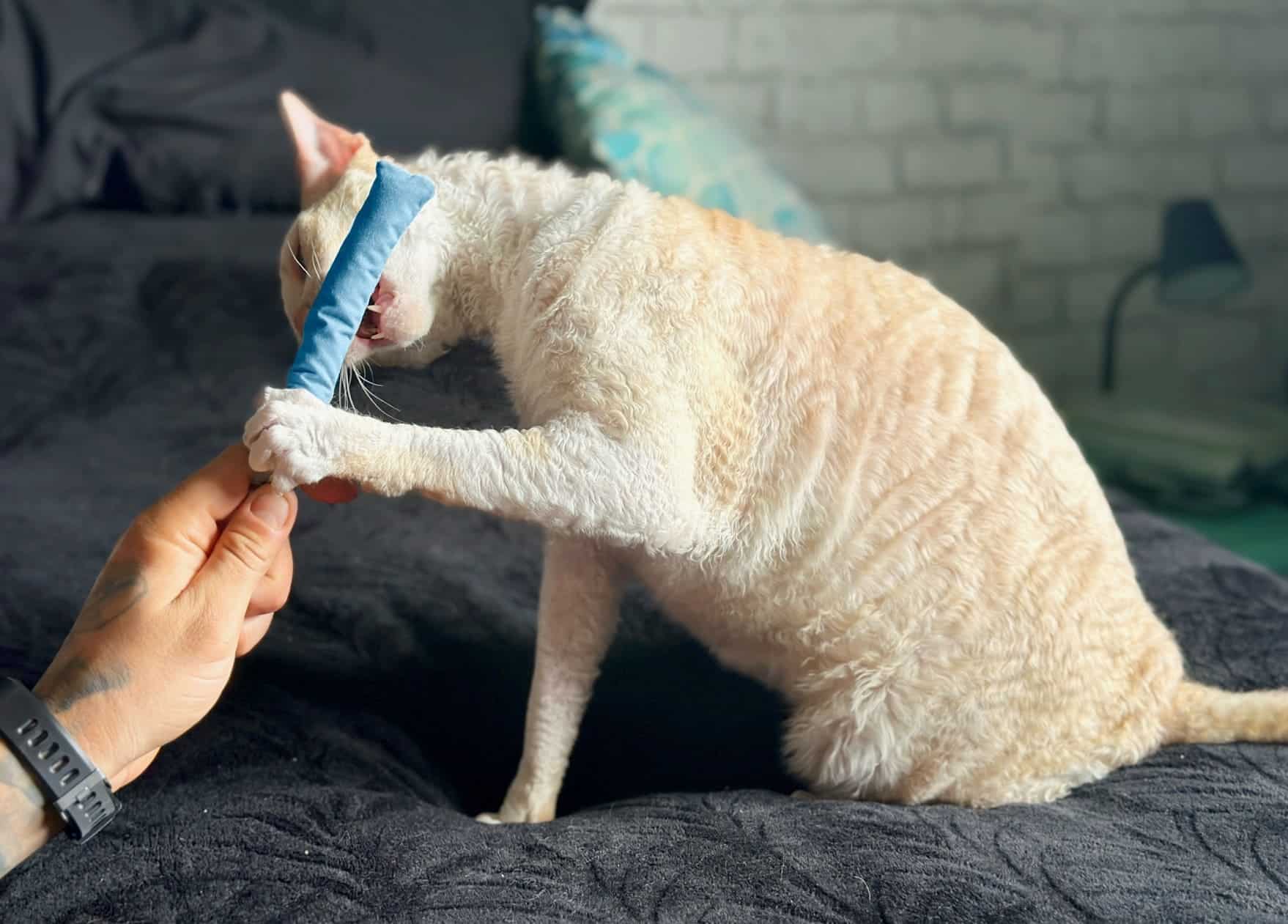
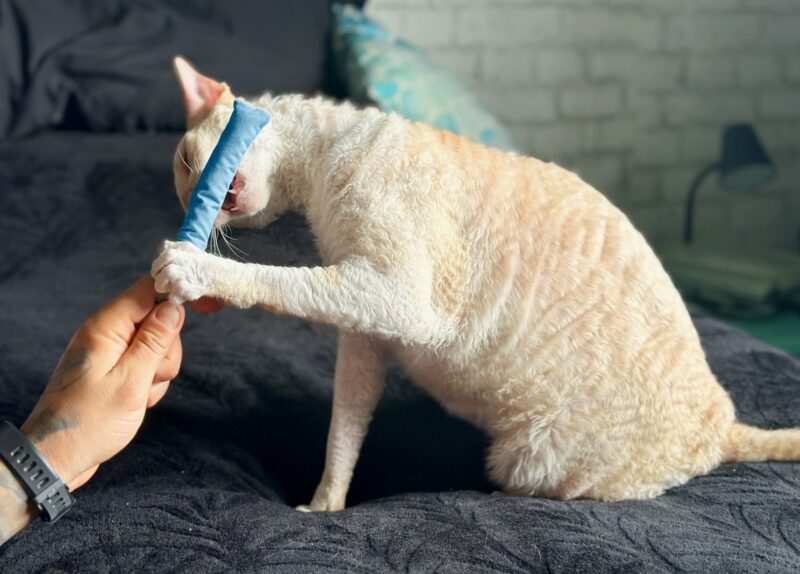





 Buyer’s Guide: How to Find the Best Cat Toy for Your Cat
Buyer’s Guide: How to Find the Best Cat Toy for Your Cat






